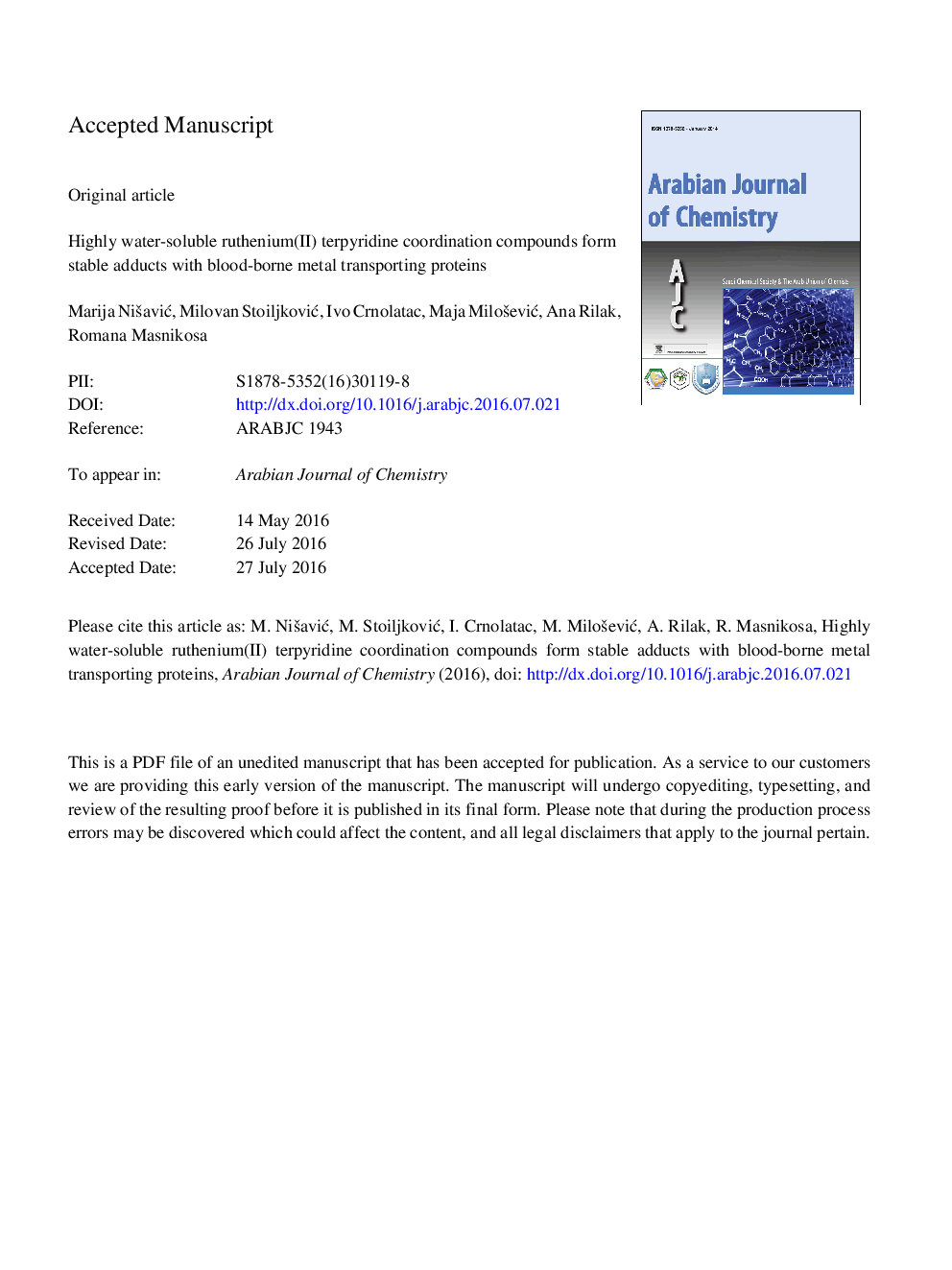| Article ID | Journal | Published Year | Pages | File Type |
|---|---|---|---|---|
| 7691562 | Arabian Journal of Chemistry | 2018 | 53 Pages |
Abstract
Three coordination compounds of ruthenium(II), belonging to a recently synthesised series of water-soluble compounds of general formula mer-[Ru(L3)(N-N)Cl]Cl, where L3 = 4'-chloro-2,2':6',2â³-terpyridine (Cl-tpy), N-N = ethylenediamine (en), 1,2-diaminocyclohexane (dach) or 2,2'-bipyridine (bpy), have shown strong binding to calf thymus DNA and moderate in vitro cytotoxicity towards cancer cell lines. Knowing that serum proteins play a crucial role in the transport and deactivation of ruthenium drugs, we have conducted a detailed study of their interactions with two major metal-transporting serum proteins, albumin and transferrin, and it is presented herein. Ruthenated protein adducts were formed with various concentrations of the three compounds and then separated from the unbound portions by ultrafiltration through 10Â kDa cut-off centrifugal filter units. The stoichiometry of binding was determined using inductively coupled plasma optical emission spectrometry. One mol of albumin bound up to 7, 8.5 and 1.5Â mol of compound 1 ([Ru(Cl-tpy)(en)Cl][Cl]), 2 ([Ru(Cl-tpy)(dach)Cl][Cl] and 3 ([Ru(Cl-tpy)(bpy)Cl][Cl]), respectively. One mol of transferrin bound up to 3, 3.5 and 0.4Â mol of 1, 2 and 3, respectively. The affinity of albumin and transferrin for the three ruthenium compounds was evaluated using fluorescence quenching. The binding constants for 1 and 2 lay within the range 104-105Â Mâ1, suggesting moderate-to-strong attachment to albumin. Both compounds showed much lower affinity for transferrin (102-103Â Mâ1). Compound 3 bound weakly to each studied protein. High resolution ESI qTOF mass spectra of albumin before and after binding of 1 revealed the high stoichiometry of binding. Although the binding of the compounds 1-3 to albumin and transferrin did not affect proteins' secondary structure much, their tertiary structures underwent some alterations, as deduced from the circular dichroism study. Changes in the stability of albumin, after binding to compounds 1-3 were examined by differential scanning calorimetry.
Keywords
2,2'-bipyridineAEMHSATM1TPYτ0apoTfPHECysUPLCfluorescence intensity in the absence of quencherDSCNAMI-APTAKP1019apotransferrinbpyTM2Stern-Volmer constantUV-VisTransferrinPBSA280λexcESIIgGTrpnuclear magnetic resonance1,10-Phenanthroline1,2-diaminocyclohexane1,3,5-triaza-7-phosphaadamantaneBSADNAICP OESKsvhuman serum albuminbovine serum albuminSerum albumin bindingEthylenediamineInductively coupled plasma optical emission spectrometrydeoxyribonucleic acidRNAribonucleic acidUltraviolet-visibleimmunoglobulin GTryptophanNMRTyrTyrosinecalf thymusBinding constantHISAnticancer drugscircular dichroismRAPTA-CDACHCysteineMolar extinction coefficientExcitation wavelengthCD spectraMass spectrometryPhosphate buffered salinePhenylalaninePhenMALDI ToF MSMethionineMETHolotransferrinhistidineDifferential scanning calorimetryultra performance liquid chromatographykappelectrospray ionisation
Related Topics
Physical Sciences and Engineering
Chemistry
Chemistry (General)
Authors
Marija NiÅ¡aviÄ, Milovan StoiljkoviÄ, Ivo Crnolatac, Maja MiloÅ¡eviÄ, Ana Rilak, Romana Masnikosa,
